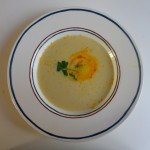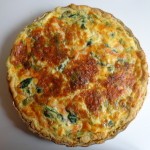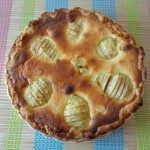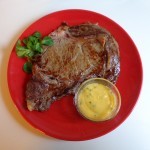 I grow artichokes in my garden in Burgundy. This spring I’ll have to start over because a wild boar trampled my two artichoke plants last autumn. Which means I’ll be lucky if I get a single artichoke by September. Happily artichokes can be found in abundance at markets in France throughout the summer and beyond. And sometimes you don’t even have to go to the market — frozen artichoke hearts are all you need. As in this soup.
I grow artichokes in my garden in Burgundy. This spring I’ll have to start over because a wild boar trampled my two artichoke plants last autumn. Which means I’ll be lucky if I get a single artichoke by September. Happily artichokes can be found in abundance at markets in France throughout the summer and beyond. And sometimes you don’t even have to go to the market — frozen artichoke hearts are all you need. As in this soup.
Soupe aux artichauts safranée / Artichoke soup with saffron
The soup is essentially a purée of artichoke bottoms with a little olive oil and cream. The saffron is what makes it really special. First, there’s the color — incandescent yellow-orange. Then there’s the sublimely exotic flavor, which is, I think, the reason why saffron is reputedly the world’s most expensive spice. Depending on how much you like saffron, you can include it in both the soup and the swirl on top, or use it only for the swirl. Personally, I like it enough to use it in both.
Meantime, the food and travel writer Ann Mah has just posted one of my recipes on her excellent site. Ann, a friend who until recently lived in Paris, has a regular column called Tuesday dinner with… where she invites other food bloggers to contribute a recipe for a dish they would make on a Tuesday evening — i.e. an evening when a fast and easy supper is called for. The recipe I sent her is Salade Savoyarde, a salad with lettuce, potatoes, country ham and melted cheese. To check it out, go to: annmah.net / Tuesday dinner with The Everyday French Chef.
Site news: One of the reasons I embarked on this culinary adventure last fall is that I’m hoping to publish a cookbook. For that to happen, I’ve been told, I need tens of thousands of followers! So how are we doing? Thanks to your interest and support, the site is nearly 8 months old and has a steadily growing following. But it’s not growing fast enough to reach 10,000 anytime soon. The Everyday French Chef needs a boost, and I’d like to ask for your help.
One way would be to send a link to the home page to 5 or 10 (or more) of your friends. Or, when you see a recipe you like, you could share it by pressing one of the buttons at the bottom of each page — via Facebook, Twitter, Email or Pinterest. And of course, if you like this site but have not yet subscribed, you may do so. I am very grateful for your support, and will keep you posted. In the meantime, happy cooking.
— Meg Bortin
 At cooking class the other day, the students wanted to make quiche. Fine. But which kind to propose? Quiche lorraine with cream and bacon felt too heavy for spring, never mind that it’s still raining in Paris. Ditto flamiche, the leek quiche that hails from northern France and Belgium. I wanted something richly flavorful with a hint of luxury and a touch of green, a dish to cheer us up in this most dire of springs. Et voilà — inspiration in the form of a smoked salmon quiche, with spinach to brighten it.
At cooking class the other day, the students wanted to make quiche. Fine. But which kind to propose? Quiche lorraine with cream and bacon felt too heavy for spring, never mind that it’s still raining in Paris. Ditto flamiche, the leek quiche that hails from northern France and Belgium. I wanted something richly flavorful with a hint of luxury and a touch of green, a dish to cheer us up in this most dire of springs. Et voilà — inspiration in the form of a smoked salmon quiche, with spinach to brighten it.











